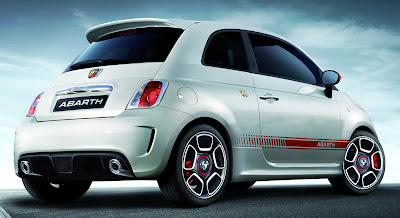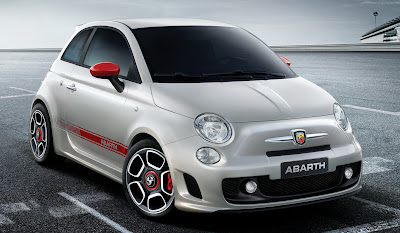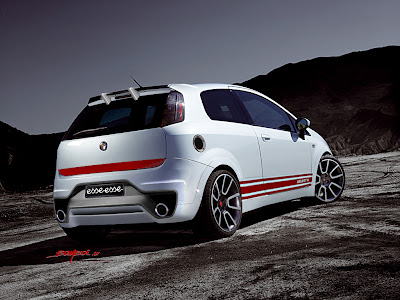Exactly one year after the rebirth of the brand and the company, Abarth returns to the Geneva Motor Show for the public launch of the long-awaited 500 Abarth. In this more detailed press kit, Fiat’s sporty subsidiary has also included five high-res images of the 500 Abarth which you can check out right after the jump.
Before we get into the mechanical details, let’s see how Abarth’s design team managed to turn the cute-looking 500 into “mighty-mouse”. The Italians added a full bodykit that consists of a new front and rear bumper, side skirts, a roof spoiler, a rear diffuser, red caps on the exterior mirrors, twin exhaust pipes, a restyled bonnet and larger, 16’’ or optionally, 17’’ alloy wheels. Furthermore, Fiat claims that the 500 Abarth’s beefy bodikt is fully functional as it helps to reduce drag and increase grip at high speed.
Inside, according to Fiat as there are no official pics out yet, the 500 Abarth features special instrumentation with sports graphics, a three-spoke steering wheel with shaped thumb rests and a ‘flattened’ bottom, aluminum pedals and ‘one-piece’ type bucket seats.
The 500 Abarth is powered by Fiat’s 1.4-liter Turbo petrol engine that generates 135 bhp at 5,000 rpm and a peak torque of 206 Nm at 3.000 rpm in ‘Sport’ mode (180 Nm at 2,500 rpm in ‘Normal’ mode). Abarth has also equipped the 500 with an electronic Torque Transfer Control system (TTC) that helps eliminate torque steer. -Details & pics after the jump
PRESS RELEASE:
All the strong points of the new car
Faithful to the saying coined for Abarth cars in the 1960s (‘small but wicked’), the 500 Abarth promises to be a ‘small’ car with generous performance qualities. The car on display at the Geneva show is equipped with a Fire. This brilliant, smooth new engine is also a friend of the environment: like the regular Fiat model it is derived from, the new Abarth will respect future Euro 5 legislation.
Another interesting feature of the 500 Abarth is the fact that it adopts the new TTC (Torque Transfer Control) system, which improves the transfer of drive torque to the wheels, but, above all, ensures that the car behaves impeccably on bends, making it safer and more entertaining to drive when you put your foot down.
World premiere of the 500 Abarth
Geneva marks the debut of the 500 Abarth which will be marketed by the exclusive Abarth network in July, to further strengthen the brand’s sporting credentials. The car was developed by the Fiat Group Automobiles Style Centre with the spirit of the legendary 500 Abarths of the 1960s, and while it is a small, agile, compact car on the outside, inside it features the best that engineering, safety and technology can offer today.
And for people with an assertive character, who love a challenge, as Carlo Abarth did, in addition to the road version prepared with the conversion kit, the small Abarth will also be offered with a racing outfit, the 500 Abarth SS Assetto Corsa, designed for customers who want to try their hand at circuit racing.
All the strong points of the new car
Faithful to the saying coined for Abarth cars in the 1960s (‘small but wicked’), the 500 Abarth promises to be a ‘small’ car with generous performance qualities. The car on display at the Geneva show is equipped with a Fire 1.4 16v Turbo petrol engine which delivers a maximum of 135 bhp (99 kW) at 5,000 rpm and peak torque of 206 Nm at 3.000 rpm in ‘Sport’ mode (in ‘Normal’ mode torque is reduced to 180 Nm at 2,500 rpm). This brilliant, smooth new engine is also a friend of the environment: like the regular Fiat model it is derived from, the new Abarth will respect future Euro 5 legislation.
Another interesting feature of the 500 Abarth is the fact that it adopts the new TTC (Torque Transfer Control) system, which improves the transfer of drive torque to the wheels, but, above all, ensures that the car behaves impeccably on bends, making it safer and more entertaining to drive when you put your foot down.
Aggressive, functional styling
Respecting Abarth tradition in full, the styling of the 500 Abarth is not a mere exercise in interpretation, because it significantly improves the car’s performance. The best proof of this stylistic approach can be found in the attention paid to the aerodynamics and functionality of certain elements. For example, compared to the basic body, the 500 Abarth optimises aerodynamic behaviour both with the roof extension and a large winged spoiler, and with a ‘slide’ that links up to the underbody, optimising the airflow output, and involving much of the rear bumper.
We should underline that these two elements – the spoiler and the slide – help to reduce drag and increase grip at high speed. What is more, the front slits on the bumper heighten the sporty styling but also perform a useful function, cooling the two intercoolers positioned at the sides. That is not all. On either side of the ‘slide’, there is an exhaust pipe that corresponds to the symmetrical exits of a single silencer positioned transversely (branded with the scorpion logo, like those in the 1960s).
On the side, sideskirts envelop the curves of the car creating a more vertical profile, which improves the Cd. But it is the front that really announces that the 500 Abarth has the equipment of a true GT: the ‘triptych’ of air intakes consists of a central inlet, which is larger than on the basic model, with a much broader upper slit (above the number plate); the two ‘nostrils’, positioned symmetrically at the sides of the bumper, correspond exactly to the position of the two identical intercoolers, which are just visible through the ‘nostrils’, guaranteeing airflow in and out.
The nose with its trim has been ‘pushed forward’ to create the space necessary for the turboblower; this makes the side view of the 500 Abarth more pronounced and obvious, in perfect harmony with Abarth tradition, recalling the 850 TC and 1000 TC, on which the externally applied manifolds were immediately visible and recognisable as a characteristic feature of the brand. The trim itself differs from the one on the Fiat 500 because it is in a single piece: the Abarth logo, which appears for the first time without a chrome surround, ‘floats’ on a finned surface that serves as an additional air intake. The Abarth shields positioned on the sides are shot through by a tri-colour arrow, like the ones on the Abarth 595 and 695 in the 1960s, a symbol of the brand’s racing image.
And finally, the 16” and 17” wheel rims come in different styles: from multiple spokes to beading of the bore holes (a clear reference to styles adopted for forged wheels in the 1970s).
‘Racing’ interiors for extremely enjoyable driving
Inside, the ‘cockpit’ of the 500 Abarth features special instrumentation which is derived from the outfit on the Fiat model, with the addition of an analogue pressure gauge to measure turbo pressure. It incorporates a LED telltale that optimises gear changes by lighting up at the appropriate moment. The main instrumental panel, with its sports graphics, is protected from glare by an upper lip, while the three-spoke st
eering wheel has shaped thumb rests, is ‘flattened’ at the bottom to increase roominess, and is adjustable. The aluminium pedals with their rubber trim have a decidedly ‘racing’ look, like the gear lever knob (covered with leather with a more anatomical grip for sporty driving). The same approach is evident in the seats – of the ‘one-piece’ type, incorporating the head-restraint into the squab – which are upholstered with a choice of materials: fabrics in different combinations of colours and textures, and two versions of leather (black or red). The headlining and the side trims are black, giving the interior a more technical, sporty look.
Fiat 500 Abarth: a story of records and successes
The roots of the new 500 Abarth go deep into the history of motorsport in the Sixties. A brief history follows of the forefather of the car displayed today in Geneva.
It all began in July 1957 with the launch of the ‘Nuova 500’, the car created by Dante Giacosa and powered by a twin-cylinder engine (capacity of 479 cc) that delivered a maximum of 13 bhp, for a top speed of 85 km/h. Carlo Abarth fell in love with this small Fiat, and immediately recognised a challenge: he was soon convinced that, with suitable tuning, it could become a very fast little car. He maintained the original cylinder capacity, but increased the compression ratio (from 6.55:1 to 8.7:1), and fitted a Weber 26 IMB carburettor and a special Abarth exhaust: this generated an extra 7 bhp compared to the basic model, bringing it up to 20 bhp which, with successive tuning stages, eventually reached 23 bhp.
On October 15, 1957 a number of similarly tuned cars, but all with standard bodywork, were sent to the Monza racing circuit for a speed test, to show that the ‘Abarth treatment’ could produce extraordinary results.
The injection of horsepower and the special Abarth edition of the ‘Nuova 500’ made a significant contribution to the success of the standard model. That same year two more versions of the new Fiat also appeared: the ‘500 Coupe’ Zagato and the ‘500 Coupe’ Pininfarina. The first won for Abarth in the Italian Class 500 Championship of 1958, driven by Ovidio Capelli. That same year, Carlo Abarth wanted to show that the ‘Nuova Fiat 500’, suitably transformed and with even more power, could produce brilliant performance (compression ratio of 10.5:1, optimised intake and exhaust, power delivery of 26 bhp and top speed of 118 km/h), and as a result for a whole week the small Fiat – sporting a Scorpion on its front – performed a ‘marathon’ that went down in history: in seven days and seven nights it covered a distance of 18,186 kilometres at an average speed of 108 km/h, breaking 6 international records, by travelling:
• in 4 days, 10,457 km at an average of 108.9 km/h;
• in 5 days, 12,933 km at an average of 108.2 km/h;
• 15,000 km in 139 hr 16’ 33” at an average of 107.6 km/h;
• in 6 days, 15,530 km at an average of 107.8 km/h;
• 10,000 miles in 149 hr 09’ 29” at an average of 107.8 km/h;
• in 7 days, 18,186 km at an average of 108.2 km/h.
With this umpteenth success, Carlo Abarth proved that it was possible to build racing cars derived from small runabouts, and the motto ‘small but wicked’ was coined.
And so the Sixties started; they have since been described as the heyday of the Scorpion, thanks to its huge success in racing and on the market. This decade also represented the period of the greatest generational rebirth in the Twentieth century. The age of technology began: in the space industry, preparations were underway to put a man on the moon, eight out of ten Italian homes now had a television, people travelled by car listening to the radio, all types of periodicals and publications were born, habits were changing, and so were the Italians.
It was no coincidence that the most important developments to the ‘500’ Abarth were introduced in this revolutionary period. In 1963, Carlo Abarth, who was a natural technologist and innovator, decided that he wanted to make the new ‘500’ even faster; so he increased the cylinder capacity from 499.5 cc to 595 cc, obtaining a power delivery of 27 bhp. The extensive work carried out on the engine and changes to the fuel feed system, with the adoption of a Solex C28 PBJ carburettor instead of a Weber unit, enabled the Fiat 500 Abarth to pass the 120 km/h mark.
The Scorpion’s small sports car was immediately recognisable by the Abarth grille on the nose, accompanied by the distinctive metal logos of the model and the Abarth shield on the sides, with the claim ‘Campione del Mondo’ (World Champion).
A few months after the market launch of the ‘595’, the plant in Corso Marche launched the ‘conversion box’ containing all the parts necessary to make a Fiat Nuova 500 identical to an Abarth 595, in terms of engineering but also of styling: pistons, camshaft, engine, cylinder head gasket, exhaust, oil sump, chrome-plated grille with lateral trims, enamel shield and chrome wording.
This showed that Carlo Abarth’s engineering genius was attune to the aspirations of the young, managing to meet the demand for brilliant performance even on cars used for everyday driving and not only to race.
For the Corso Marche plant, 1964 began with the presentation of the Fiat Abarth ‘595 SS’, an even more evolved, more powerful version of the ‘595’. This small bombshell developed as much as 32 bhp for a top speed of over 130 km/h, causing quite a stir in the racing world. It differed from the previous model for the black rubber hooks on the bonnet, the ‘SS’ logo on the front and rear lids, and ‘esse esse’ written on the dashboard.
They were stylistic details that underlined the sporty personality of this small car. And it was by then customary for Abarth to market not only the car but also a conversion kit that allowed the owner of a Fiat 500 to transform it into a ‘595’ SS, and to put himself behind the wheel of a real Abarth sports car.
The last version of the ‘595’ was the ‘595 SS Competizione’: wider track, wider tyres, wheelarches with protruding red shanks, a power delivery of 34 bhp and a top speed of 130 km/h. In other words, Carlo Abarth had created a new car for new victories. The roll of honour of this runabout with the Scorpion treatment included a long, long list of triumphs, from its debut at the Monza circuit in 1964 with Franco Patria, right down to the Italian Touring Trophy 600 class with Leonardo Durst at the end of the same year.























